Togo Mizrahi
(1901-1986)
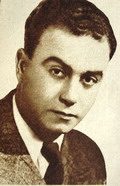
Togo Mizrahi
(1901-1986)
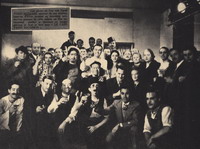
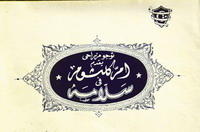
Back cover of the programme of Sallama starring Omm Kalthoum
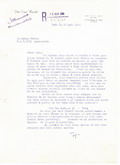
Letter dated 18 August 1966, from Togo Mizrahi to Behna Brothers,
requesting subscriptions to Egyptian cinema magazines,
and noting that Omar Sharif had become an international star.
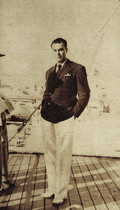
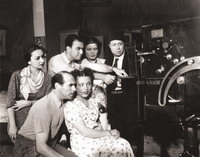

Shalom
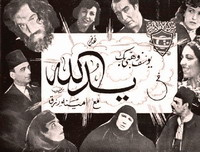
Divine Providence (Yadu Allah)
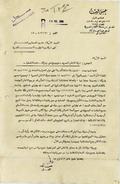
Letter dated 14 July 1966 from the liquidator of the Egyptian Films Company, Mr. Hassan Labib, to the representative of the General Sequestrator of Behna Films, notifying him that the Egyptian Films Company films, photographs, posters, promotional material and exclusive distribution rights were sold to one Taha Zaafarani Tantawi on 4 July 1966.
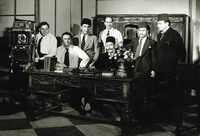
Togo Mizrahi with Sami Brill to his right, and Youssef Wahbi and Stéphane Rosti standing behind him
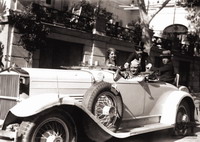
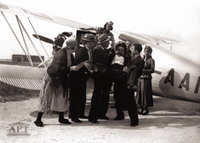
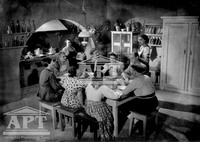
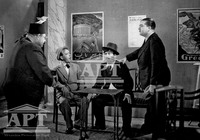
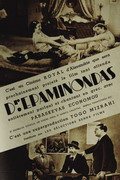
Stills from Mizrahi’s Greek films
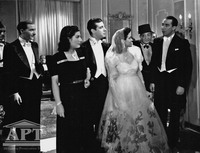
Laila from the Countryside (1941)
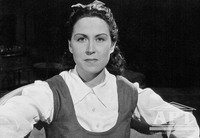
Laila the School Girl (1941)
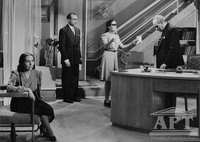
Laila in the Dark (1944)
Togo Mizrahi is not only one of the founding fathers of Alexandrian cinema in the thirties, but he also contributed greatly to Egyptian cinema as a whole. Equally important is that the forceful presence and the total integration of Togo Mizrahi, an Italian Jew, into the Alexandrian scene attest to the tolerance and co-existence of the cosmopolitan Alexandria of his time, where diverse ethnic and religious groups lived in harmony. This cosmopolitan spirit seems to have infiltrated into Mizrahi’s consciousness for it was to figure in a number of his films, such as Seven o’clock and The Two Delegates.
Mizrahi was born on 2 June 1901 to an Italian family that lived in Alexandria. After receiving his education in Alexandrian schools and earning a diploma in commerce, he left for Italy in 1921 to continue his studies. He then went to France but eventually came back to Alexandria in 1928 with a Ph D in economics.
On his return, he started his career in cinema by issuing a newsreel in Alexandria. He then founded The Egyptian Films Company and turned to feature films.
In his first film The Abyss (el Hâwiyah) in 1930, Mizrahi proved to be a man of many talents for he produced, directed, edited, acted, designed the set and wrote the script. This film was made in Bacos Studio, a cinema theatre which Mizrahi had bought and converted into a studio with a plateau, the necessary equipments and actors’ rooms. It was in this studio that he made all his Alexandrian films until he moved the premises of his company to Cairo in 1939. The film premiered in Alexandria and was next shown in Cairo on 2 February 1931, but under a new name, Cocaine (el kokaïn).
Togo chose to act under the pseudonym of Ahmed el Meshriqi, and his brother, who acted in this film, used the pseudonym Abdel Aziz el Meshriqi.
Mizrahi, who was in the habit of discovering new actors, presented in this film Shalom, a Jewish actor, who became a famous comedian in Egyptian cinema. Shalom was to work with him in a number of films such as 5001(khamsat âlaf wa wâhid)in 1932,Shalom the Dragoman (Shalom el tourgmân) in 1935, Much Wealth is a Nuisance (el ‘Izz bahdalah) in 1937, and Shalom the Athlete (Shalom el riyâdî) in 1937.
In the following year, Mizrahi directed his second feature film 5001(khamsat âlaf wa wâhid)and in 1935, he directed his first sound film Children of Egypt (Awlâd Misr).
After his first three films Cocaine (el kokaïn), 5001 (khamsat âlaf wa wâhid), and Sons of Egypt (Awlâd Misr), which basically tackled social issues, he was to shift to comedy. He started with The Two Delegates (el Mandoubân) in 1934, a comic film starring the most famous duet of the Egyptian theatre at the time, Fawzi and Ehsane el Gazayerly . Mizrahi was to capitalize on the success of that film by teaming up with that successful duet in other films which he also acted in, Dr. Farahat (el Doktor Farhât) in 1935 and The Sailor (el bahhâr)in 1935.
After his successful experience with the Gazaerlis, he worked with Ali el Kassar, another famous comedian of the time. Together, they made nine successful films: One Hundred Thousand Pounds (Mit alf guinih) in 1936, The Guard of the Barracks (Khafir el darak) in 1936, Seven o'clock (el Sâ‘ah Sab‘ah) in 1937, The Telegram (el Telegraf) in 1938, Osman and Ali (‘Othman wa ‘Ali) in 1939, The Thousand and One Nights (Alf Lailah wa Lailah) in 1941, Ali Baba and the Forty Thieves (‘Ali Bâbâ wa-l-arba'in harâmi) in 1942,and Nour Eddine and the Three Sailors (Nour Eddine wa-l-bahhârah el thalâthah)in 1944. Interestingly enough, the last three movies were inspired by folktales and Arabic heritage. The spectators greatly enjoyed the hilarious stories of the unlucky Nubian, played by Ali el Kassar, not only because of his naiveté and the absurd situations he got into, but also because of his ethnic clothes and strong Nubian accent.
One of Mizrahi’s most notable contributions to Egyptian cinema was that he turned Laila Mourad, the famous Egyptian singer and actress, into a legendary figure by presenting her in a new light. Together they made five films which he produced and directed: A Rainy Night (Laylah moumtirah) in 1939, Laila from the Countryside (Layla bint el rif) in 1941, Laila the School Girl (Layla bint el madâris) in 1941, Laila (1942), and Laila in the Dark (Layla fi-l-zalâm) in 1944.
Mizrahi had another successful experience with Greek cinema for he produced and directed four Greek-speaking films which were a success in Greek cinema theatres. It was customary for Greek theatrical troupes to finish off their season with a grand tour to different countries where they would perform their plays before the Greek communities. The largest and most important Greek community was the one in Egypt. That is why most of the Greek theatrical troupes presented their plays in Alexandria, Cairo, Port Said and Ismailia from the turn of the twentieth century till the fifties.
When Mizrahi met the Kaltos Sisters Troupe in 1937, while they were performing in Egypt, he approached them with a translated script of a film he had already directed, Dr. Farahat, which he proposed to produce and direct for the troupe. The troupe immediately agreed to his proposal and the film was made and shown in Greece under the title of Doctor Epaminondas. The success of the film seems to have triggered competition for in 1938, the owner of the largest Greek troupe, Sofia Fembo, approached Mizrahi with a script, which he was to direct and produce for her, and in the same year he was to direct and produce another Greek film for the Kaltos Sisters Troupe. Finally, in 1943, he directed and produced The Sailor for the Kaltos Sisters, a film which he had already directed in 1935.
Another important film in Togo's career is Sallama (Sallâmah) in 1945, a historical film set in the Umayyad times, starring the most famous Egyptian singer Oum Kalthoum.
Towards the end of his career, he produced films that were directed by young promising Egyptian directors: The Son of the Blacksmith (Ibn el haddâd)in 1944, Divine Providence (Yadu Allah) in 1946 and The Great Artist (el Fannân el 'azîm) in 1945 by Youssef Wahbi, Mohamed Ali Street (Shâri’ Mouhammad ‘Ali) in 1944 and Beauty Queen (Malikat el gamâl) in 1946 by Niazi Mustafa, and Appearances el Mazâhir in 1945 and Love Train (Express el houbb) in 1946 by Hussein Fawzi.
In 1939, with the outbreak of World War II, Mizrahi moved to a studio in Cairo, on 4, Hosni Street, Guiza, while retaining his old one in Bacos. Until the studios were sequestrated then liquidated in the 1960s, the letterhead of the The Egyptian Films Company continued to carry the two addresses: Studios Bacos and Studios Guiza. Mizrahi himself left Egypt for good in 1948, settling in Rome until his death in 1986.
The studios went on functioning under the direction of his nephew Alfredo, who operated from Cairo, until the The Egyptian Films Company was liquidated in 1966. Thus ended the Mizrahi saga in Egypt.
While he worked at a reduced rate in the cinema in Rome, due to health problems, Mizrahi continued to show a keen interest in what was happening in Egypt. He arranged for a subscription to the Egyptian cinema magazines El Messawar and El Kawakeb, although money and transfer arrangements had become complicated during the 1960s. Wanting a little bit of Egypt in Rome, he asked Georges Behna for some of his old posters and photographs with which to decorate his office, and though all material had had to be handed over to the liquidator of the Egyptian Films Company, Georges did manage to find some in his stores to send to his friend. Mizrahi also followed Omar Sharif’s rise to international stardom, and noted that he was now acting with Sophia Loren. His personal letterhead carried, in addition to his Rome address, his Egyptian one at Guiza, complete with telephone number.
Filmography:
1930: Cocaine or The Abyss (el kokaïn) (el Hâwya)
1932: 5001 (khamsat âlaf wa wâhid)
1933: Sons of Egypt (Awlâd Misr)
1934: The Two Delegates (el Mandoubân)
1935: Doctor Farahat (el Doktor Farhât)
1935: Shalom the Interpreter (Shalom el tourgmân)
1935: The Sailor (el bahhâr)
1936: A Hundred Thousand Pounds (Mit alf guinih)
1936: The Guard of the Barracks (Khafir el darak)
1937: Too Much Money is a Nuisance (el ‘Izz bahdalah)
| 1937: Too Much Money is a Nuisance (el ‘Izz bahdalah) |
1937: Shalom the Athlete (Shalom el riyâdî)
1937: Seven o'clock (el Sâ‘ah Sab‘ah)
1938: The Telegram (el Telegraf)
1938: This is my nature! (Anâ tab ī Kidah)
1939: Osman and Ali (‘Othman wa ‘Ali)
1939: Lend me Three Pounds (Sallifnî talâtah guinîh)
1939: A Rainy Night (Laylah moumtirah)
| 1939: A Rainy Night (Laylah moumtirah) |
1940: The Chief Contractor (el Bâchmouqâwil)
1940: The Heart of a Woman (Qalb imira’ah)
1941: The Three Musketeers (el Foursân el thalâthah)
1941: Laila from the Countryside (Layla bint el rif)
1941: One Thousand and One Nights (Alf Lailah wa Lailah)
1941: Laila the School Girl (Layla bint el madâris)
1942: Laila (Layla)
1942: Ali Baba and the Forty Thieves (‘Ali Bâbâ wa-l-arba'in harâmi)
1943: The Right Path (el Tariq el moustaqîm)
1943: Long live Women! (Tahyâ el sittât)
1944: Laila in the Dark (Layla fi-l-zalâm)
1944: Lies, Lies! (Kidb fi kidb)
1944: Nour Eddine and the Three Sailors (Nour Eddine wa-l-bahhârah el thalâthah)
1945: Sallama (Sallâmah)
1945: Long live Men! (Tahyâal-riggâlah)
Greek-Speaking Films:
1937: Δκρ· Επαμινόνδας
Doctor Epaminondas (Doktor Epaminondes)
1938: Προσφυγοπούλα The Girl Refugee (Prosfigopoula)
1938: Όταν ο σήζυγος ταξιδυει When the Husband is Absent (Otan o syzygos taxidevi)
1943: Καπετάνιος Σκορπιός Captain Scorpion (Kapetan Skorpios)
Films produced by Togo Mizrahi and directed by others:
1944: The Son of the Blacksmith (Ibn el haddâd)
1944: Mohamed Ali Street (Shâri’ Mouhammad ‘Ali)
1945: Appearances (el Mazâhir)
1945: The Great Artist (el Fannân el 'azîm)
1945: Love Story (Qissat gharâm)
1946: Divine Providence (Yadu Allah)
1946: Love Train (Express el houbb)
1946: Beauty Queen (Malikat el gamâl)
References:
- Daoud, Abdel Ghani. El Rahloun fe Ma̓at ‘Âm. Cairo: Wezârat el Thaqafah, 1997.
- El Hadari, Ahmed, Tarikh el Cinema fi Misr. 1896-1930. Cairo: Publications of the Cinema Club, 1989.
- Hassan, Elhami. Tarikh el Cinema el Misreyah. Cairo: Sondouk el Tanmeyah el Thaqafiyah, 1995.
- Melakhrinoudis, Yannis. El Yonaniyoun fi el Cinema el Misreyah. Alexandria: Bibliotheca Alexandrina, 2003.

